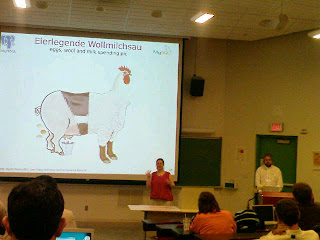Thursday, May 22, 2008
Tuesday, May 20, 2008
Mobile Device Sales Decline in the U.S.
Sara Silver of The Wall Street Journal reports:
U.S. purchases of new cellphones declined in the first quarter for the first time in several years, signaling that worries about an economic slowdown are hurting the handset market, according to two new studies.
The drop was concentrated among poorer customers using prepaid plans and among households earning $75,000 to $99,000 a year. The upper end of the cellphone market -- phones featuring full keyboards for email and text messaging, and extra features for music downloads and video viewing -- continued to see growth.
The overall decline in handset sales also comes amid finds that growth in wireless-service subscriptions is slowing as the market reaches saturation, with 83% of the U.S. population owning a cellphone now.
...
This trend benefits makers of feature-rich handsets such as Samsung Electronics Co., LG Electronics Co., BlackBerry-maker Research in Motion Ltd. and iPhone maker Apple Inc. Motorola has struggled to add high-end phones and has lost market share as a result.
At the end of the first quarter, Motorola held 25% of the U.S. cellphone market, compared to 34% at the end of the first quarter of 2006, according to Strategy Analytics. During the same period, Korean competitors Samsung had increased its share of the U.S. market to 22% from 15% and LG rose to 21% from 16%. RIM's BlackBerry devices comprised 8% of the market, enabling the company to take the No. 4 slot from Nokia Corp., the global market leader.
Thursday, May 8, 2008
Saturday, May 3, 2008
Soft phones in Java !
I remember the days when people were wondering about Java's survival.
Today it is used in some of the coolest, most disruptive telecommunications technologies.
VoIP-info.org has a list of these technologies which include some soft phones in Java. I'd be interested in knowing if anyone has tried them. Some samples are: Ubiquity's SIP User Agent, NIST's JsPhone and iptel.org's BonePhone.
Has any of you used any of these phones?
SIP Roles and Activities
Session Initiation Protocol (SIP) specification (RFC 3261) describes four main types of roles. The user agent client (UAC), the user agent server (UAS), the redirect servers and proxies. There are also many activities defined such as registration, querying for capabilities, dialogs, initiation of a session, modification of an existing session and termination of a session.
Many commercial and non-commercial operating systems are now embedding the SIP protocol stack. These are often accompanies by APIs to implement any one of the various roles in any one of the activities described in RFC 3261. The trick then becomes to conceive of applications. Many of the authors of RFC 3261 have done exactly that. For example, you can take a look at Henning Schulzrinne's many papers in this area, describing various use models explored in his labs at Columbia University.
SIP is about to become the de facto session initiation and control signaling protocol dominating the converged world of Internet-based communications technologies and services such as VoIP. (On the related subject of VoIP, see the recent post by Richard Giles on VoIP on Java. There's of course much more that can be said about VoIP and SIP.)
In the JCP, there are several SIP-related JSRs. These are JSR 32 (JAIN SIP API Specification), JSR 116 (SIP Servlet API) and JSR 125 (JAIN SIP Lite).





